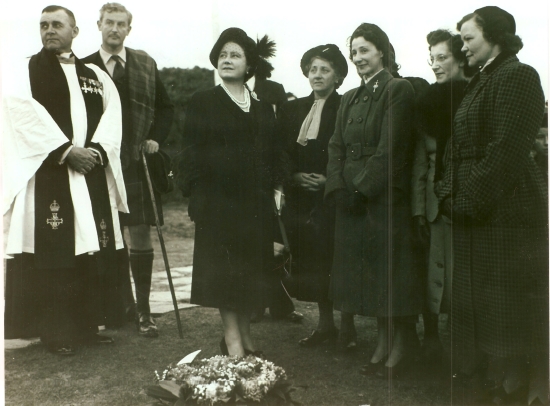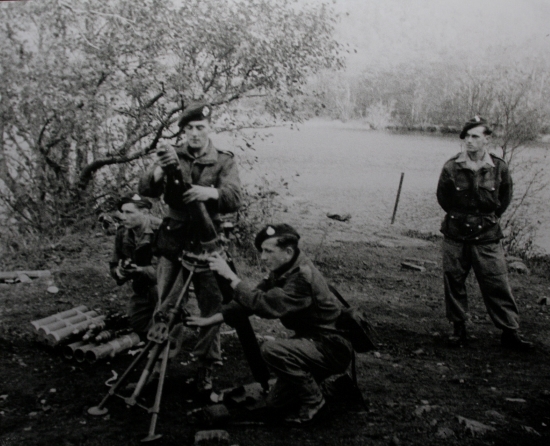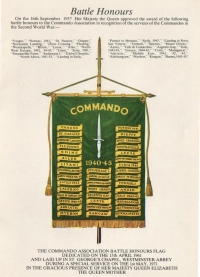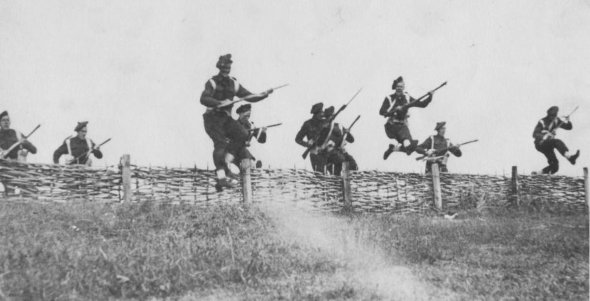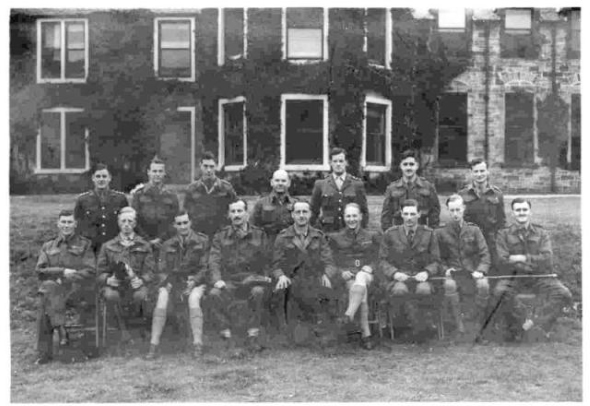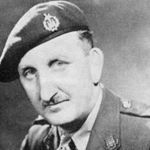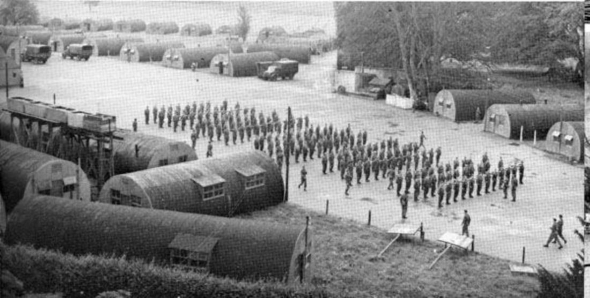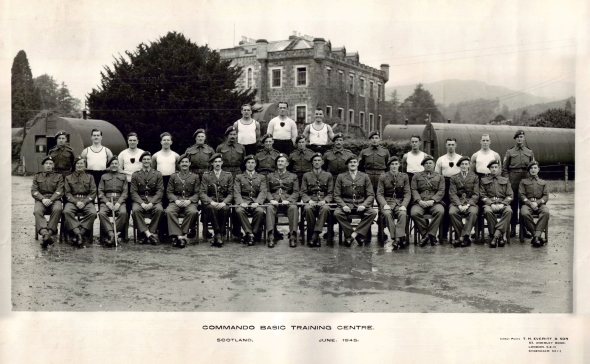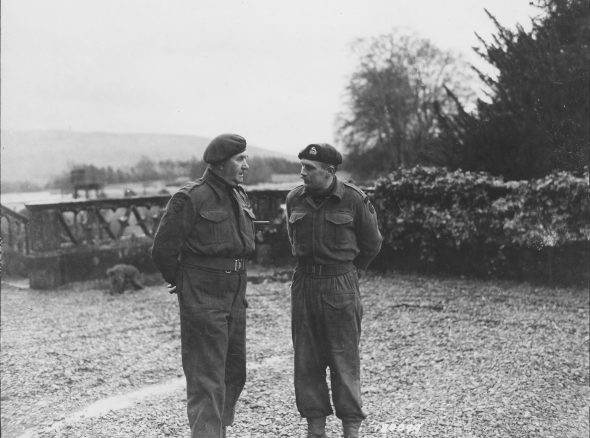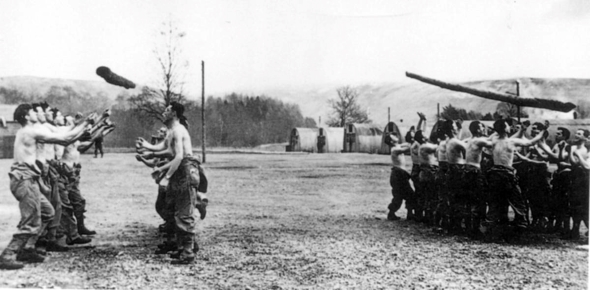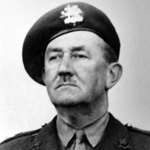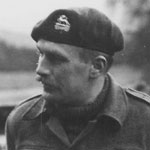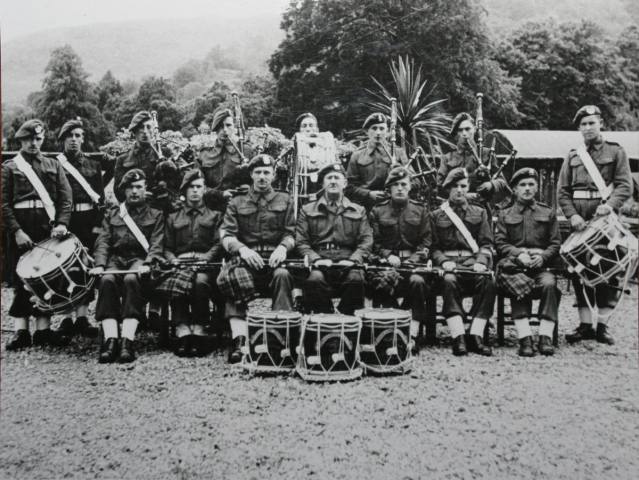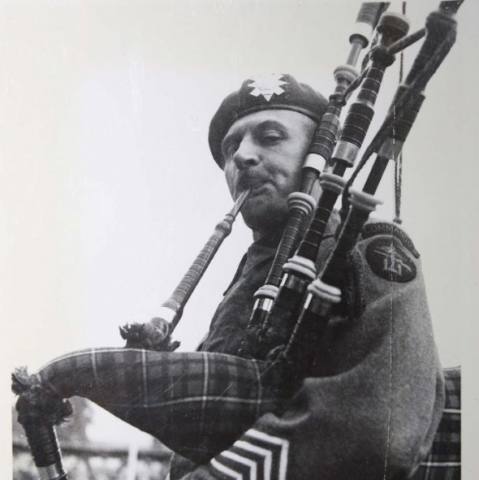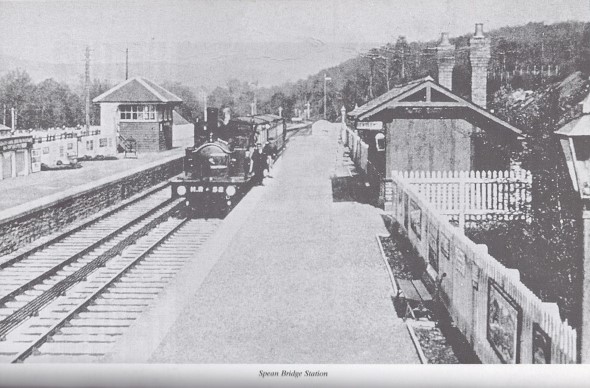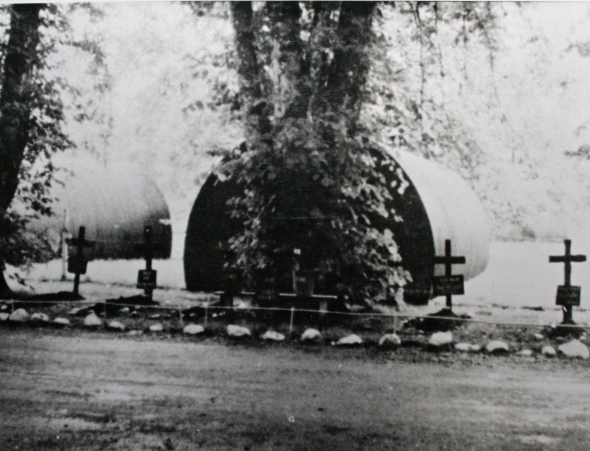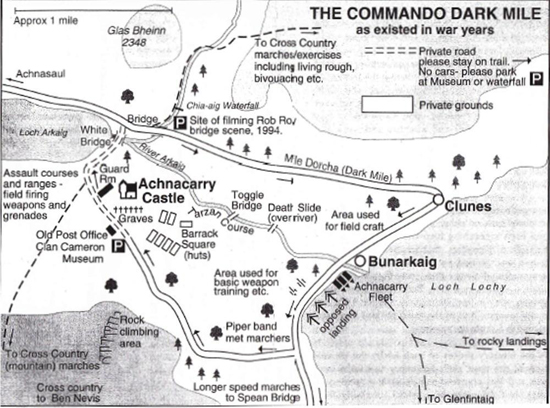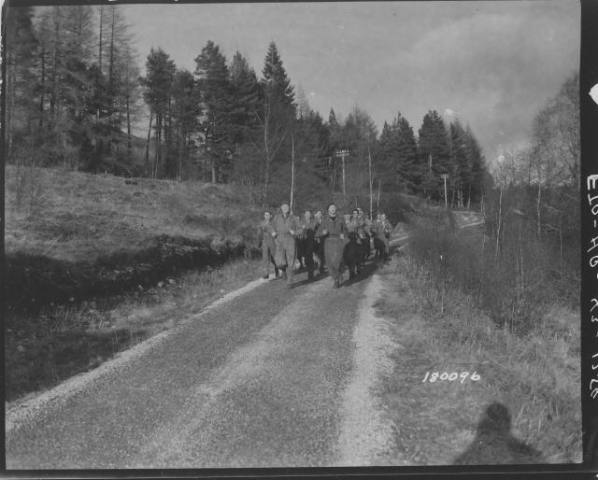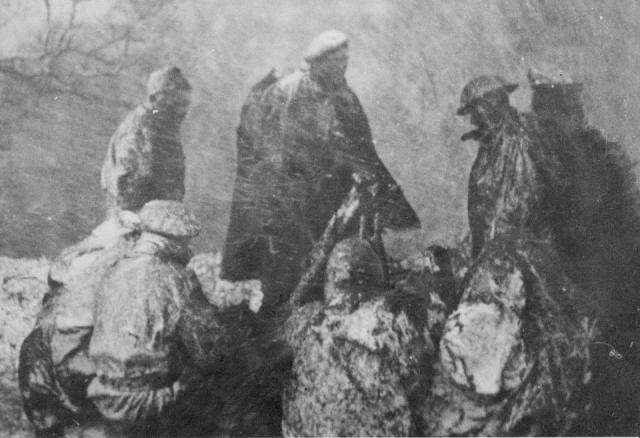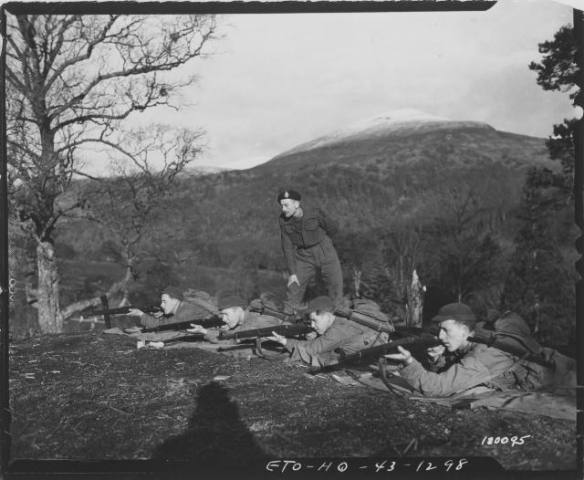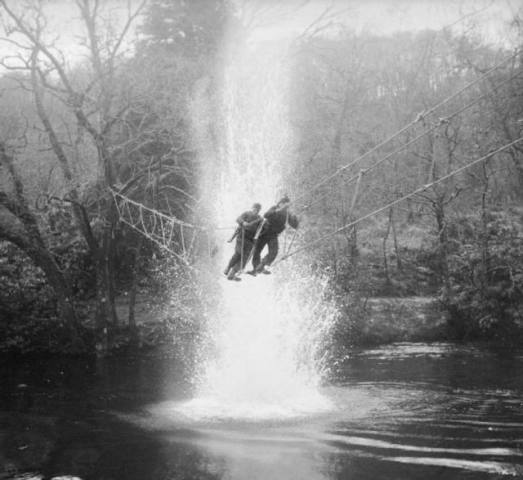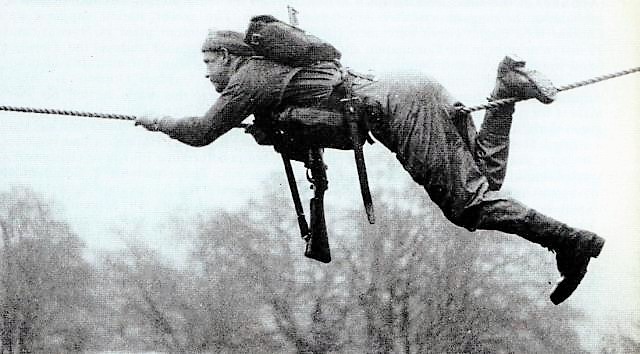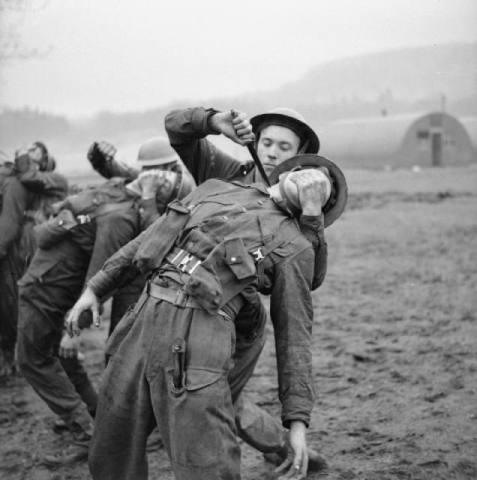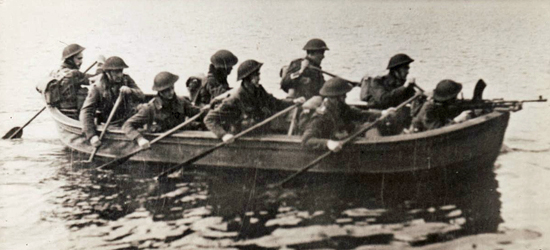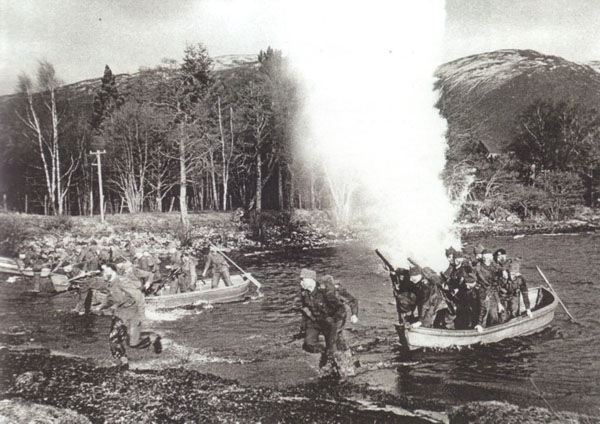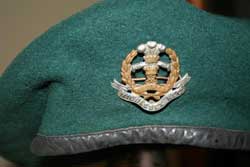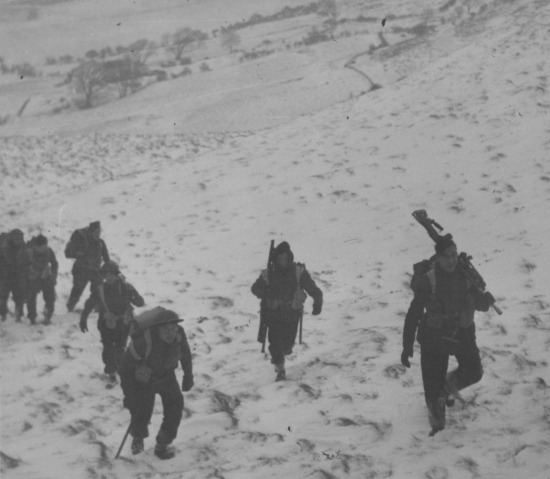
'History and Training 1940 -1945'
Introduction
- Purchase James Dunning's book here It Had to be Tough
- Purchase Donald Gilchrist's book here Castle Commando.
- We have a section in our gallery dedicated to commando training.
© Commando Veterans Archive 2014.
-
WW2 Training Centres - Roll of Honour [view......].
* The original Commando Association stood down in 2005. Some members then formed a new group, the Commando Veterans Association. They reverted to Commando Association in June 2019.
Read on from below......
Commando Battle Honours
"It is with great pride and pleasure that we are now able to report a successful conclusion to our enquiries, commenced over two years ago, about the possibility of the Association being granted Battle Honours. As the result of preliminary correspondence with the War Office, we received news in March, 1957, to say that approval had been given by Her Majesty the Queen for the award of Battle Honours to commemorate the services of the Commandos in the Second World War, and that, as a special case, claims could be submitted on behalf of the Commando Association.
The work was mainly organised, and claims compiled, by the General Secretary, and was co-ordinated under and during the term as President of Colonel A. C. Newman, V.C., O.B.E., T.D., D.L. After consultation with Brigade Commanders and Commanding Officers, our application was duly completed, and in October last an official notification appeared in the Press to the effect that thirty-eight Battle Honours had been awarded to the Association. The awards have since been confirmed, and appeared in List No. 11 of Battle Honours notified in Army Order 113 of 1957.
In the words of our President, Lt. Colonel J, M. T. F. Churchill, D.S.O., M.C., in his letter to all C.O s and O.C.A. Branches in October last, we hope that all members will feel satisfied with the Battle Honours we have been awarded, and that the relations of those killed in action will find in their proud and resounding names some consolation for their own tragic loss."
Here then are our Battle Honours for the war of 1939-45.
Vaagso, Norway 1941, Litani River, Syria 1941, North Africa 1941/3, North West Europe 1942, Djebel Choucha, Sedjenane 1, Dieppe, St Nazaire, Steamroller Farm Tunisia, Landing in Sicily, Pusuit to Messina, Sicily 1943, Landing at Porto San Venere, Termoli, Salerno, Monte Ornito, Anzio, Valli di Comacchio, Argenta Gap, Italy 1943/5, Greece 1944/5, Crete, Madagascar, Adriatic, Middle East 1941, 1942, & 1944, Normandy landings, North West Europe 1944/5, Dives Crossing, Flushing, Westkapelle, Rhine, Leese, Aller, Alethangyaw, Myebon, Kangaw, Burma 1943-5.
View our Gallery images here of the Laying up of the Commando Association Battle Honours Flag at Westminster Abbey on 1st May 1971.
Read on from below right ......
A timeline of Commando Training
The first call for volunteers for ‘Service of a hazardous nature’ was in the early months of 1940 and for the new Independent Companies. Many of these men went onto action in Norway almost immediately with little training. On their return Winston Churchill wanted his own Corps of ‘shock troops’ to start afresh. Lt Col Dudley Clarke, who was then Military Assistant to the Chiefs of the Imperial General Staff, is generally credited with the initial outline plan of their formation. His plan was approved and the name agreed on. Thus the ‘Commandos’ were formed.
A Combined Training Centre (CTC) at Inverary and a Special Training Centre (STC) at Lochailort (see above photo) had been established. The latter consisted of Nissen huts and tents, with the headquarters installed in Inverailort Castle, about 27 miles West of Fort William. A powerful team of instructors were gathered there, with many going on to became well known leaders of irregular forces, including the Chindits and Special Air Service, all being formed after the Commandos. The Instructors included Lord Lovat, Brigadier 'Mad Mike' Calvert, Colonel Spencer Chapman, Major Peter Kemp, and the Sirling brothers Bill and David.
Additionally other Officers and NCO's with a wide range of experiences from arctic exploring to rugged campaigning on the North West frontier of India, plus those well versed in signalling, demolitions, and shooting. Two of these Instructors were Messrs Fairbairn and Sykes of Shanghai Police fame. These two men, more than anyone else in the British Army were responsible for the introduction of unarmed combat and close quarter fighting.
From July 1940 Officers and selected NCO's from the newly formed Commandos attended STC courses, and then returned to blend the techniques and skills acquired with the other new ideas being developed within the training regime of their own Commandos.
The castle of Achnacarry, and the grounds, was the seat of Sir Donald Walter Cameron of Lochiel, Chief of the Scottish Clan Cameron, who in June 1940 had given hospitality to No. 1 Independent Company. In December 1940, Achnacarry, as well as nearby Achdalieu Lodge, were officially brought into use as part of the the new Training and Holding Wing for the main Special Training Centre (S.T.C.) at Lochailort and remained as such for the next year.
A decision was made to centralise all Commando training at Achnacarry. In December 1941 Achnacarry was re-designated as The Commando Depot, and passed under the authority of the Special Service Brigade. The first courses began in the months of February/March 1942. Achnacarry was now the training centre for all Commandos in the UK and was known as the Commando Depot, later renamed the Commando Basic Training Centre.
For Commandos already deployed overseas, additional training areas were set up including the Training and Holding Unit at Geneifa beside the Great Bitter Lake in the Middle East
The first Commandos were all Army Commandos. Twelve Army Commandos were raised in 1940 and had been involved in operations since then.
It was not until February 1942 that the first Royal Marine Commando unit was raised, initially designated as the 'Royal Marine Commando', then redesignated 'A' RM Commando when a second RM Commando was formed in October 1942, before finally being designated as 40 Royal Marine Commando, Royal Marines. Nine RM Commando units were in existence by the end of the war.
There were also Royal Naval Beach Commandos and RAF Servicing Commandos, and groups given Commando designations for a limited period or a specific purpose, some examples being No.14 Commando, No.62 Commando, and 142 Commando Company.
View a Roll of Honour of those who died at training centres: WW2 Training Centre Deaths
Read about the origins of the green beret here: History of the Commando Green Beret
Read about the origins of the fighting knife here: History of the Commando Fighting Knife
View a brief outline on this link to other Commando Training Centres from their formation until the present time.
- Donald Gilchrist, CBTC Instructor and author of Castle Commando.
- James Dunning, CBTC Instructor and author of It Had To Be Tough.
- Commando Veterans Archive Gallery
- The No 10 Independent Company War Diary
Read on from below right ......
'A document on the object of Special Service'
3. Mentally. The offensive spirit must be the outlook of all ranks of a Commando at all times.
4. Physically. The highest state of physical fitness must at all times be maintained. All ranks are trained to cover at great speed any type of ground for distances of five to seven miles in fighting order.
a. Fighting Order (seven miles in one hour (march & run).
b. F.S.M.O. (Full Service Marching Order)
5. Cliff and mountain climbing and really difficult slopes climbed quickly form a part of Commando training.
7. Seamanship and Boatwork. All ranks must be skilled in all forms of boatwork and landing craft whether by day or by night, as a result of which training, the sea comes to be regarded as a natural working ground for a Commando.
8. Night sense and night confidence are essential. All ranks will be highly trained in the use of the compass.
9. Map reading and route memorising form an important part of Commando training.
10. All ranks of a Commando will be trained in semaphore, morse and the use of W/T.
11. All ranks will have elementary knowledge of demolitions and sabotage. All ranks will be confident in the handling of all types of high explosives, Bangalore torpedoes, and be able to set up all types of booby traps.
12. A high standard of training will be maintained in all forms of street fighting, occupation of towns, putting towns into a state of defence and the overcoming of all types of obstacles, wire, rivers, high walls, etc.
13. All ranks in a Commando should be able to drive motor cycles, cars, lorries, tracked vehicles, trains and motor boats.
14. A high degree of efficiency in all forms of fieldcraft will be attained. Every man in a Commando must be able to forage for himself, cook and live under a bivouac for a considerable period.
15. All ranks are trained in first aid and will be capable of dealing with the dressing of gunshot wounds and the carrying of the wounded.
16. These are a few among the many standards of training that must be attained during service in a Commando. At all times a high standard of discipline is essential, and the constant desire by all ranks to be fitter and better trained than anyone else.
17. The normal mode of living is that the Special Service Soldier will live in a billet found by himself and fed by the billet for which he will receive 6s. 8d. per day to pay all his expenses.
18. Any falling short of the standards of training and behaviour on the part of a Special Service Soldier will render him liable to be returned to his unit.
Source: The document and history behind it is detailed in the book 'It Had to be Tough' written by the late Major James Dunning, a former TSM in No.4 Commando and Instructor at the Commando Depot (later renamed the Commando Basic Training Centre) at Achnacarry.
Read on from below right ......
'Commando Basic Training Centre'
The Commando Depot at Achnacarry, redesignated as the Commando Basic Training Centre (CBTC), was regarded as one of, if not, the finest of all the Allied special training centres established in the Second World War.
Its reputation was widespread and held in the highest regard by all the Allies, for not only were soldiers and marines of the British forces trained there, but also those from the USA, France, Holland, Belgium, Poland, Norway, and surprisingly, some Germans. These were the ‘Free’ Germans and included Jews who had escaped the tyranny in their own country. Many other Units also used the facilities of Achnacarry. A list of the Courses can be found in our Gallery here [Courses at the CBTC].
The grounds and castle of Achnacarry was the seat of Sir Donald Walter Cameron of Lochiel, Chief of the Scottish Clan Cameron, who in June 1940 gave hospitality to No.1 Independent Company.
Commando training was not centralised at this time with each individual Commando unit responsible for their own training. In December 1940, Achnacarry, as well as Achdalieu Lodge, were officially brought into use as part of the the new Training and Holding Wing* for the main Special Training Centre (S.T.C.) at Lochailort and remained as such for the next year. A Training Centre was also operating at Inverary.
STC Lochailort was however scheduled to be closed. A need had been seen to centralise all commando training with a Commando Course that everyone would have to pass. Thus in December 1941 Achnacarry was re-designated as The Commando Depot, and passed under the authority of the Special Service Brigade.
Around the drill square hard asphalt now replaced the green lawn of the Castle. This square was surrounded by austere Nissen huts with their corrugated iron sides and roofs. These were the accommodation huts, each housing between 25 and 40 men, and also used as dining 'halls', washing rooms, and the NAAFI canteen. Occasionally these were complimented by Bell tents when additional accommodation was required. Achnacarry was now the Commando Basic Training Centre (C.B.T.C.), however we have found references to the old Depot name still being used long after.
In his book "It had to be Tough" Major James Dunning, who served on the staff at the CBTC for a period, states the following, "Normal intakes of trainees were allocated to one of the three training Commandos: Keyes, Haydon or Sturges, named after pioneers of Combined Operations and the Commandos. Admiral Sir Roger Keyes, our first beloved boss, and his son Geoffrey, who won the first Commando VC; General Haydon, the original commander of the Special Service Brigade and leader of the Lofoten Islands Raid; General Sturges, a Royal Marine, who after the Madagascar operation became the first overall commander of the Commando Group of four Commando Brigades.
Much of the PT consisted of agility and strengthening exercises, and teaching the drills and skills of tackling obstacles. All the equipment and obstacles were home made at Achnacarry by the staff. The photo depicts trainees using logs, each about 15-20 feet long, as part of that training. The logs were heaved, hurled in the air, and caught in a variety of different improvised strengthening exercises, demanding in addition, plenty of team work and cooperation.
More can be read about other areas of training in the pages to follow.
It would be remiss not to mention more about the man tasked with organising and controlling such demanding training, Lieutenant Colonel Charles Vaughan. Major Jimmy Dunning, No.4 Commando and CBTC, wrote " A Veteran of the First World War and the Retreat from Mons in 1914. In the inter war years he graduated from Drill Sergeant to RSM, but he was much more than just a bawling barrack square man, although he could do that if needed. His obvious military potential as an officer was recognised and he was duly commissioned.A Londoner by birth and proud of it, Lieutenant Colonel Vaughan's standards for soldiers and soldiering were set by his long service in war and peace. He accepted nothing but the best, whether it be in fitness, training, weaponry and musketry, fieldcraft and tactics, drill and turnout, or even in the more apparently mundane matters of administration which included feeding and hygiene.
Together all these factors made the 'whole' - and the self disciplined and reliant Commando soldier 'fit to fight' and 'fighting fit' with high morale, willing and capable of tackling any military task, under any circumstances, and against any odds."
Primary Sources: Donald Gilchrist, CBTC Instructor and author of Castle Commando; James Dunning, CBTC Instructor and author of It Had To Be Tough; Hilary St. George Saunders author of The Green Beret (The story of the Commandos 1940-1945.); No 10 Independent Company War Diary National Archives ref. WO.218/17]
© Commando Veterans Archive 2014
* Follow this link to read the No 10 Independent Company history. [relevant to the early timeline.]
Follow this link to view the dates of Course Intakes at Achnacarry.
Read on from below right ......
VAUGHAN, Charles Edward (Lt Col)
Charles Edward Vaughan, born 1893, was originally attached to No.7 Commando. The then Major Vaughan took over as Acting Second in Command of No.4 Commando on 30 June 1941 replacing Major M.G. Kerr before taking up his role as the Commandant of the newly formed Commando Depot (CBTC) at Achnacarry.
On June 6th 1964 during the ceremonies in Ouistreham commemorating the 20th Anniversary of the D Day Landings, the Commando Memorial window at the church of St Sampson was unveiled by Lieut. Colonel Vaughan. The window had been donated by the Association to the people of Ouistreham as a token of appreciation for their continued hospitality and kindness to Commando Veterans attending D Day Anniversaries. In January 1965 Lieut. Colonel Charles Vaughan OBE represented the Association at the funeral service in St Paul's Cathedral for Sir Winston Churchill.
Donald Gilchrist author of 'Castle Commando' wrote :
Read on from below right.....
COCKCRAFT, William Gordon La Trobe
- The IWM have an Oral Interview (catalogue number 3935) recorded with Major William Gordon La Trobe Cockcraft covering the period he served with the Royal Berkshire Regiment and the training of the 4th Bn King's African Rifles in Uganda, Kenya and East Africa, 1938-1942. (He received a Mention in Despatches for distinguished service during this period*). At the very end of the last reel (reel 2) Major Cockcraft states he left them to volunteer for the Commandos [3] .
- 13 August 1949 Major Cockcraft retired from service [4].
'Lt. Col. Vaughan confers with his 2 i/c, Major Cockcraft', image
[Caption] "Lt. Col. C.E. Vaughan, Commandant of a Commando Depot confers with this Second in Command, Major Peter Cockraft* on the day's schedule for a Ranger Unit. Speanbridge, Scotland."
CBTC Demonstration Troop
CBTC Pipe Band and Demonstration Troop
- More photos in our Gallery [view.....].
Arrival at Spean Bridge Railway Station
Read on from below right ......
'Commando Dark Mile training areas'
A good map of the various locations of training described on our archive.
Read on from below right ......
'Boat Training at Bunarkaig'
The Commando Boat Station at Achnacarry was on Loch Lochy at Bunarkaig. A small fleet of various craft was assembled for training in basic seamanship and landing drills. Amongst this armada were whalers, cuters, landing craft, dorries, canoes, rubber dinghies, kapok bridge rafts, and collapsible Goatleys. They were all stored in or moored alongside a little stone boathouse. Instruction began with a short film on the role and functions of Combined Operations, and the various craft used for training and operations.
Elementary watermanship in the folding boats, canoes, and rubber dinghies followed with the correct handling and use of paddles and oars for steering and propulsion.Once these fundamentals had been mastered it was onto the normal craft for operational landings, the assault landing craft, concluding with the opposed landing.
The Boating Officer from 1943-45 was a Royal Marine officer, Jim Keigwin, a most competent and first class instructor, and an excellent organiser, with his fleet ever ready and in good condition.
The night assault landing is described by Donald Gilchrist in his book Castle Commando as " By far the most spectacular of all the Achnacarry training schemes." He goes on to say that it was as close to battle conditions as they could get without actually slaughtering half the trainees.
The trainees were loaded into boats at Bunarkaig, they then rowed or paddled - depending on the type of boats employed - across the waters of Loch Lochy, and carried out a mock attack against a heavily defended section of the shore of the Loch.
It may have been a mock attack but was certainly not a mock defence. The attack route was carefully planned and determined. Any deviation from it would put the trainees in grave danger. They were confronted by an arsenal of weapons manned by an army of instructors skilled in the Achnacarry art of shooting to miss - but not by very much". There was no blank ammunition used. "The weapons of defence, from the mortars to the rifles, spatout live stuff - and spat it out in vast quantities".
Sources: The late Donald Gilchrist, CBTC Instructor and author of Castle Commando and James Dunning, CBTC Instructor and author of It Had To Be Tough
© Commando Veterans Archive 2014.
Read on from below right ......
'Cliff Assaults' Combined Ops Pamphlet 24
'Commando Mountain Warfare Training Centre' (CMWTC)
Initially formed at Braemar in Scotland in December 1942 and called the Commmando Snow and Mountain Warfare Training Centre. The Commanding Officer was Squadron Leader Frank Smythe, an accomplished mountaineer. Its role was to train Commandos to fight in high snow covered mountain territory. After 6 months the unit moved to North Wales and assumed a different role including the training of Lovat Scouts as a Mountaineer Battalion.
At the end of 1943 the unit again moved this time to St Ives and again its role changed to one of training Commandos for cliff assaults as part of the training for the forthcoming D Day landings. On the 9th September 1946 the centre was renamed the Commando Cliff Assault Centre RM (CCAC). [1]
Several ex Army Commandos such as Jimmy Dunning were 'seconded' to the Royal Marines for their respective roles at the centre. The centre at St Ives finally closed in 1950.
Sources [1] RMRO 1135 dated 5th Sept.1946.'C.M.W.T.C History 1943-45'
This document has a brief history of the Commando Mountain Warfare Training Centre (C.M.W.T.C) with a nominal roll from 1943 to 1945. It was prepared for a C.M.W.T.C. commemoration dinner on 30 November 1945. If the document does not load immediately in the viewer, refresh this page, or download from above.
A reunion of the CMWTC at St Ives
This is an account of a Commando Mountain Warfare Training Centre reunion held at St Ives on the 24-26th September 1993 as outlined in Commando Association Newsletter 98 of March 1994.
"This Reunion, held over the weekend 24th-26th September, was an unqualified success, and, congratulations are due to the hard work put in by Slim Sutherland, Jim Smith, Peter Dietz, Mike Banks, Ken Broom, Jack Hunter and C/Sgt. Tony Boyle (currently serving with RM Mountain and Arctic Warfare Cadre) were well rewarded. The purpose of the reunion was to commemorate the 50th Anniversary of the original Commando Mountain Warfare Training Centre's (CMWTC) move from Llanwryst to St. Ives in 1943 and for all those commando comrades who subsequently served there during the period 1943 to 1950. As such, it was, of course, a unique reunion, including not only wartime members of our own Commando Association, but also those post-war RM Commandos of the Commando Cliff Assault Centre (CCAC) and its Successors. As a result, it was natural that the number of original CMWTC veterans would be outnumbered by latter day RM Commandos. This was inevitable, but only enhanced the occasion and provided evidence of continuity.
Unfortunately, because of ill-health, neither Geoffrey Rees-Jones, a pioneer Commando climber who commanded CMWTC when it moved to St. Ives, nor the legendary Commando climber, Capt. Joe Barry, were able to attend, but two others of that move 50 years ago were, Major Jim Fraser who also commanded CMWTC and CSM George 'Dickie' Dicks, BEM. One of the features of the weekend was a demonstration by today's direct descendant of CMWTC, the RM Mountain and Arctic Warfare Cadre, They put on impressive demonstrations of abseiling from a helicopter and a cliff assault.
On Saturday evening, the main event of the re-union, the official Dinner for the ex-Commandos and their families, was held in the St. Ives Rugby Club. Just on I00 comrades and guests sat down to the meal. Piper Bill Millin was in attendance. As guest of honour, Major Jimmy Dunning, who was the last Adjutant of the CMWTC, and subsequently on renaming, the first Adjutant of the post-war CCAC, recalled the unique spirit of the unit that survived the traumas of the 'demob-happy' days of 1945 - 46 and the fight that Major Easton, MC (then CO) had to ensure that the techniques of Commando climbing and rocky landings were preserved by the survival of the unit in peacetime. He also recalled 'Commando Week', June, 1946, when the unit appealed to the locals and holiday makers through a week-long series of events for £1,000 for the Commando Benevolent Fund. He reminded his listeners that they succeeded in raising that sum, which today equates to at least £125,000. Not a bad effort for a Unit of about 50 all ranks.
The weekend reunion ended with a simple but moving open-air service at St. Nicholas Chapel, the Island, St. Ives, and this was conducted by the Revd. Richard Baxter, who in 1945 - 46, served in CMWTC. Among those who attended were Capt. Mickey O'Brien, who flew in from Malta and Glyn Vaughan, who made the long journey from Australia."
Read on from below right.....
Training Centres WW2
'Courses at CTC Inveraray'
Courses for the Special Service Brigade and SCU.
Date |
Units Trained |
| Oct '40 | 3, 4, 6, & 8 Commandos |
| Nov '40 | 7 Commando |
| May '41 | 1, 2, 3, 9, & 12 Commandos |
| Apr '42 | 1 Servicing Commando RAF |
| May '42 | 3202 & 3203 Servicing Commando RAF |
| Aug '42 | Two RAF Servicing Commandos |
| Sept '42 | 2 Commando 1st, 2nd, & 3rd Bn's. 168 Regt. 168 US Combat Team 1st, 2nd, & 3rd Bn's 26 Regt. 26 US Combat Team |
| Mar '43 | 5 RAF Commando |
| May '43 | 3205 & 3206 Servicing Commando RAF |
| Jun '43 | 3207 & 3208 Servicing Commando RAF |
| Jul '43 | 3209 & 3210 Servicing Commando RAF |
| Jun '44 | 1, 2, & 3 Independent Mountain Company Norwegian Brigade Independent Para Company Norwegian Brigade |
Read on from below right.....
Commando Basic Training Centre Staff, Achnacarry,1945
Commando Basic Training Centre Staff, Achnacarry,1945
FILM 'The Story of the Green Beret
An hour long film made for the Admiralty in 1945, this is a drama-documentary covering Commando training in Wrexham, Achnacarry and St. Ives. Fascinating archive footage shows wartime Commando units on amphibious assault exercises, perfecting cliff-top assaults and practicing both armed and unarmed combat techniques.
As said above the film was made for the Admiralty. The viewer should be aware that the first Commandos formed in 1940 were in fact all Army Commandos. It was not until 1942 that the first two RM Commando units were raised, followed by 5 more in Aug 43, with the last being raised in 1944. In 1946 all the Army Commandos were disbanded, along with five of the eight RM Commando Units. It would not be until many years later that Army Commandos would return to support the RM Commandos of 3 Commando Brigade.
If you have come to this film page first and want to know more about the history of the training, then go the start of the Commando Training section HERE.
Read on from below right.....
'Achnacarry Christmas 1945'
After a brief spell "off the record" we again present the latest news. We have said farewell to our late Commandant, Lt. Col. A. G. Komrower, D.S.O., Lancashire Fusiliers, and simultaneously had the pleasure of welcoming our new Commandant, Lt. CoL Martin Price, D.S.O., R.M. Our comrades-in-arms, the Army Commandos, have also left the Centre and we are at present in the throes of the great changeover.
Read on from below right.....
Police Volunteers
3rd Police Intake - 15 October 1942 to 18 January 1943, total 84.
ALMONDS, John Edward
ANDERSON, Barrie Sherwill Norman
ANDREWS, Alfred Archley
- 12.10.1936 joined the Metropolitan Police, warrant number 125297.
ANSELL, Arthur James
ASHTON, Colin William
ASHWORTH, James Kenyon
AUSTIN, Selwyn Ronald
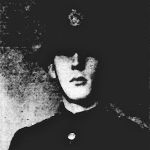
BAGOT, Henry Hunter
BAINES, William
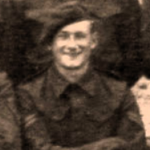
BAKER, Albert
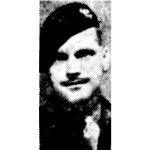
BAKER, Herbert Valentine
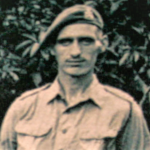
BAKER, Kenneth Claude
BALE, John Henry
BALL, Percy William
BALLANTYNE, George
BARDENS, John Henry
John Henry Bardens was a Police Officer from Plymouth who volunteered for the Commandos enlisting 6 June 1942 joining the 2nd Police Intake to the Commando Depot (Commando Basic Training Centre), Achnacarry.
BARLOW, Jack
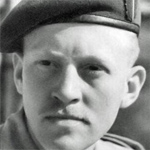
BARNES, Norman Alfred George
BARNES, William Walter
BARRASS, Nicholas William
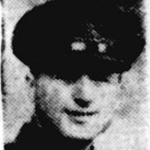
BARTLETT, Brian, V.
BARTON, Leslie James
BEARNE, Robert Stanley
BEATTIE, James Simpson
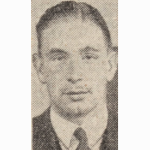
BEAVER, Stanley
BENNION, Thomas James
BENTLEY, Charles
BENTLEY, Donald
BERRY, James Arthur
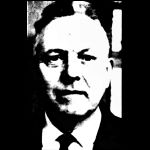
BETTY, Arthur John
BINNIE, John
BISHOP, Arthur
BISHOP, Frederick Walter
BISSELL, Stanley
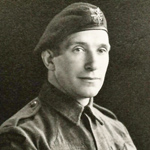
BLAKEMAN, Albert John
BOOTH, William Martel
In 1939 William Booth was an Essex Constabulary Police Constable based at South Street Police Station, Romford. He volunteered for the Commandos in 1942 as part of the Police Intakes to the Commando Depot (Commando Basic Training Centre), Achnacarry.
BOYES, Robert Paul
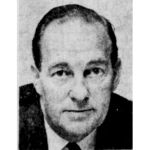
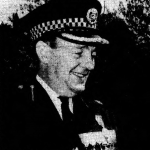
BRADLEY, John Percy
BRIDLE, Desmond George
BROUGH, William Gordon
BROWN, Kenneth Sidney
BRUNT, Morris Raymond
BRYANT, J.
BUCKLAND, Reginald Arthur
Reginald Arthur Buckland joined the Metropolitan Police on 2 September 1939 as a Special Constable and subsequently became a War Reserve Constable.
BUNT, Reginald Melford
BURKE, Edmund
BURNS, Norman
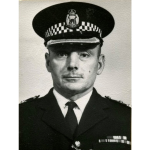
CALLAGHAN, Dennis
Private Dennis Callaghan, 6 Troop, was wounded on 13 September 1943 during operations at Salerno, Italy. Dennis was a Police Officer who had volunteered for the Commandos in 1942 and was part of a Police Intake to the Commando Depot (Commando Basic Training Centre), Achnacarry.
CAMPBELL, Thomas
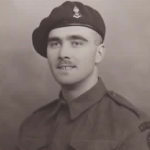
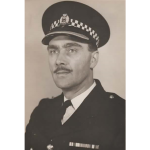
CANT, Evelyn Arthur George
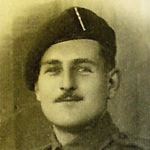
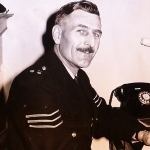
CAPP, William Thomas
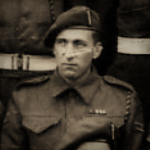
CAPPLEMAN, John
CAPSTICK, Norman
CARRICK, George
CARTER, Donald, A.
1939 - Metropolitan Police Constable residing at the Police Section House, King David Lane, London E1. Volunteered for the Commandos as part of the 1st Police Intake of 1942.
CARTWRIGHT, William
CHAPMAN, William Jopp
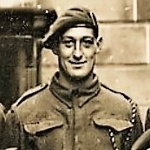
CHEETHAM, Gerald
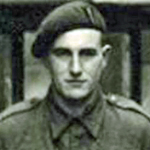
CHESTERS, William
CHITTY, Wyndham Roland, G.P.
CLARKE, Hilary Laurence
CLARKE, Patrick Joseph
CLARKSON, George Francis
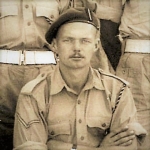
CLEMENTS, Albert Edward
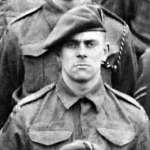
Private Albert Clements served in 1 Troop and was injured in 1943 during training at Gibraltar after which he was evacuated to the UK for treatment.
COBLEY, Victor Charles
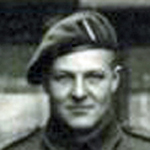
COKER, James Thomas
COLEMAN, Lloyd William
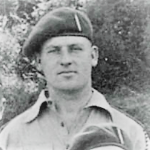
CONWAY, John Alphonsus
COOK, Kenneth
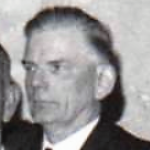
From 1994 onwards he was the Secretary of the Bristol Branch of the Commando Association.
COOKSON, Charles
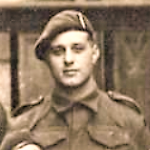
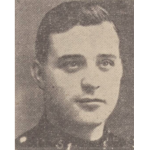
COOPER, Dudley Edward
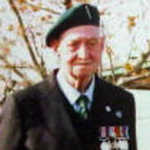
COOPER, George
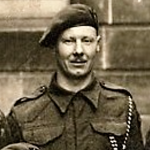
COULSON, John Richard
COULTHARD, Arnold, C.
COX, Cecil Ernest Robert
CRABTREE, Ben
CRAIG, John
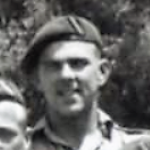
CRAIG, Robert
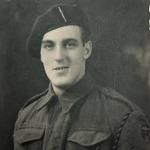
CRAIG, Robinson Ostle
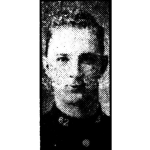
Private Robinson Craig was killed in action at Dragone Hill, near Vietri, Salerno. He was buried there the following day, his grave being marked with a cross. However it was never again found and Private Craig is one of the many who now have no known grave.
CROWE, Edward Louis
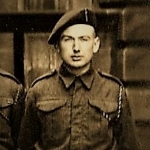
CUNNINGHAM, Stephen
DAVID, Douglas, W.
- 9 February 1939 joined the Metropolitan Police, warrant number 125614. Later resided at Blackheath Police Section House, Greenwich, SE10.
DAVID, Gordon Percy
DAVIDSON, Douglas Oscar
DAVIES, Arthur Henry William
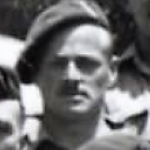
DAVIES, Leonard
Private Len Davies served in 5 Troop and later the H.Q. Section. He was a serving Police Officer in Barrowford who volunteered for the Commandos as part of the Police Intakes in 1942.
DAVIES, Wyndham Francis
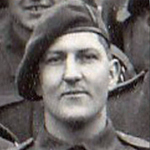
DAVISON, John Cyril
DAW, Herbert Frank
DELL, Charles Richard (under review)
DENHAM, Joah Selwyn
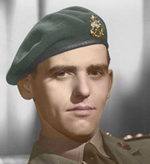
DENNIS, Thomas Gerald
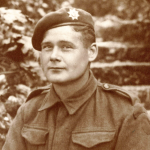
DICKINSON, John Leonard
DIGHTON, Derrick John
DOCKERILL, Graham Dennis
DOLBY, William Arthur Watkins
DRIVER, John
DRURY, Thomas
Private Thomas Drury served in the HQ Troop Motor Transport Section. He was a serving Police Officer who volunteered for the Commandos as part of the Police Intakes. In 1939 he was a Police Constable residing in Dewsbury.
DUNFORD, Edwin
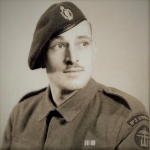
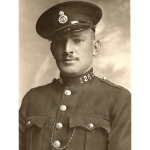
DUNKLEY, Eric Cambrai
EADS, Peter

EARL, Dennis Victor
EAST, Gerald Thomas
ELMS, Frank
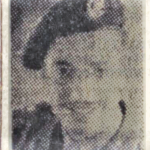
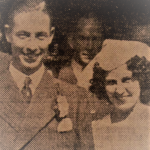
ENNIS, James Francis
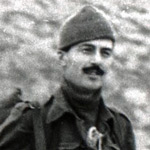
EVANS, Arthur Walter
EVANS, Goronwy Wyn
EVANS, Gwilym
Private Gwilym Evans was reported missing 14 July 1943, later presumed killed in action, during operations at Agnone, Sicily, and the bridge at Malati (later called 3 Commando Bridge).
EVANS, Leslie Daniel
EVERETT, William, J.
FANTHAM, Maurice
FEATHERSTONE, Charles Roland
FERRIE, James, E.
Sources
FLETCHER, Edmund Frederick
FLETCHER, John Harold
FORSYTH, William John
FRASER, John George
18.07.1932 attested into the Scots Guards aged 18, civil occupation Labourer. Military service included deployment to Egypt.
22.12.1936 transferred to Army Reserve to join the Police.
FROST, Sidney Edward
FRY, William Charles
GALE, William S.
Private William Gale was wounded on 13 July 1943 during operations at Agnone Sicily and the bridge at Malati (3 Commando Bridge).
GARRETT, Albert Charles
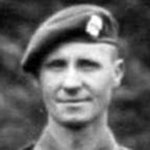
GARRETT, William John Stanley
GILL, L.M. (Len)
GODDARD, Alfred
GRANT, Archibald Campbell
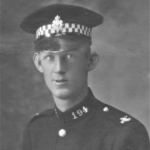
GRANT, James
GRAY, Reginald Halliday
GREALEY, Thomas Louis
GREER, J.C.
- 15 November 1944 (Guardsman) (Scots Guards) wounded in Italy [2].
GRIEVE, John
GRIGG, Eric Alfred
GROSE, Reginald George
- 1939 Police Constable residing at 162 Stanhope Street, Camden.
- 27 June 1941 awarded the George Medal.
HACK, Ronald Roger Louis
HADDOW, David Foster
HALLIDAY, Bernard Neil
- 02.01.1939 joined the Metropolitan Police.
HANTON, James Reith
HARRISON, Ivan
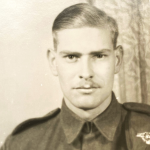
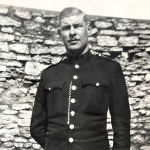
HARRY, John Grismond
HENDERSON, Walter, H.
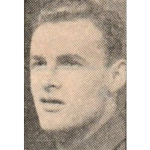
HENDRY, William
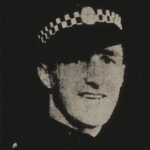
HERN, Gordon
HERSTELL, Ernest Maxwell
HEWITT, Albert John Henry
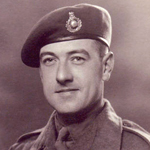
HEWITT, Denis Story
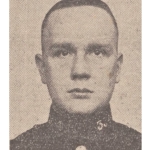
HILL, Arthur Charles
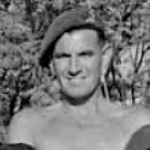
HILL, Eric Albert
HILL, Harry Leslie
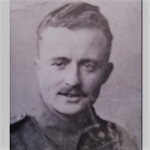
HILL, Reginald
HILLIARD, James Johnstone (record query)
03.04.1939 Police Constable serving at Gosport Police Station.
15.01.1941 serving at Fareham Police Station.
HODGES, William Albert
HOLLAND, James
HOLLINGWORTH, Leslie
HOLMES, Kenneth Samuel Buller
HOOPER, Samuel, L.
HORSFIELD, Harry
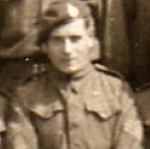
HOUGH, Richard
Sources
HOUGHTON, Walter Roy Fairley
HOWARD, Edward John
HUMBLE, William McLean
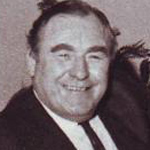
HURLEY, Philip
IMRIE, Bruce Berriff
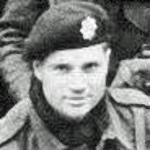
INNES, James Fraser
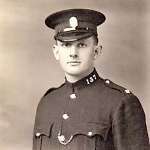
Privates James Innes was wounded on 5 October 1943 during operations at Termoli, Italy. He was a Police Officer in Larbert who volunteered for the Commandos in 1942 joining a Police Intake to the Commando Depot (Commando Basic Training Centre) at Achnacarry.
IRVINE, J.F.
IRVING, Robert, Anderson
IVES, Arthur Christopher
JACKSON, Colin
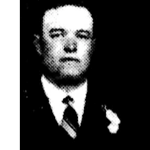
- 20 September 1938 joined the Police Service.
- 1939 single and a Police Constable residing at 191 Shelley Road, Preston.
JACKSON, Ernest Stanley
JACKSON, H.
Lance Sergeant H. Jackson was wounded on 24 March 1945 (remaining on duty) during operations to cross the River Rhine at Wesel and again on 11 April 1945 at the River Aller.
JARVIS, Joseph Augustus
Joseph Jarvis was a Metropolitan Police Officer who volunteered for the Commandos joining HM Armed Forces on 19 May 1943. In 1939 he was a Constable based or residing at 62 Wapping High Street, Stepney. Post war member of the Commando Association.
JOHN, William, H.
JOHNSON, Henry Horace
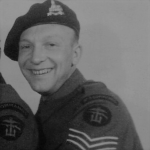
JOHNSON, Herbert
JONES, Anthony Windsor
JONES, George Edward
JONES, Kenneth Edwin
JONES, Thomas Ellis
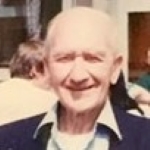
JOSS, James
KEERY, William James
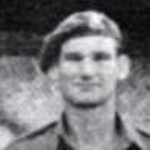
KELLY, Brian Bernard
KENDRAY, Harold
KENT, Frederick, P.
KIRBY, William John
LAMBERT, Peter Laurence
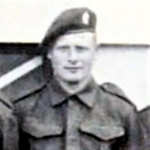
LAMKIN, Sydney James
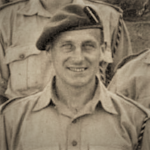
Fusilier Sydney Lamkin, a Metropolitan Police War Reservist, volunteered for the Commandos and was part of the 1st Police Intake to the Commando Depot (Commando Basic Training Centre) at Achnacarry. He was attached to No.2Commando and served in the Heavy Weapons Troop.
LATHAM, Leslie James
LEEMING, William Cedric
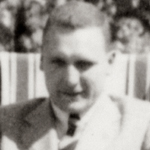
Troop Sergeant Major William Leeming died during operations at Rots and Le Hamel, France. Son of William Herbert and Alice Leeming, of Dublin, Irish Republic.
LEES, Archibald
LESSONS, George Sutherland
LEWINGTON, Leslie John
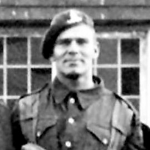
LITTLER, Ronald
LLOYD, Edmund John
LOASBY, Ronald William
LOCKWOOD, Frank
LOGAN, Frederick James
- 2 September 1939 Frederick Logan became a Metropolitan Police War Reserve Constable and in 1942 he volunteered for the Commandos.
LOGAN, Thomas Alex
MACGOWAN, Sydney James Watt
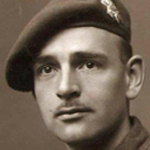
MACKENZIE, Roderick Gimson
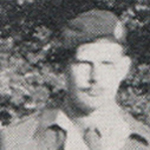
MADRA, Robert Peter
MAHAN, Robert McKenna
Fusilier Robert McKenna Mahan, 'C' Troop, was wounded on 6 June 1944, remaining on duty, during operations at Normandy, France. Post war member of the Commando Association residing Guisborough, Cleveland, Teeside.
MANLEY, Frederick, Reuben, W.
- 6 June 1944 wounded (remaining on duty) on 6 June 1944 at Normandy, France [1].
MANNING, Frederick
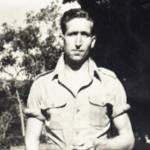
Corporal Frederick Manning, a Police Officer from Kent, was one of the Police Intakes to the Commandos commencing his training 15 October 1942. He served with No.5 Commando in the Far East and post war resumed his service with the Police.
MARRON, Austin
MARTIN, Donald Hugh
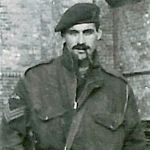
MASSEY, Albert William
MATHER, Ernest Griffith
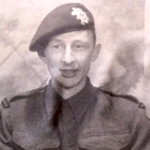
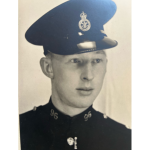
MCCUBBIN, Duncan Stuart
MCDAID, Francis
MCDONALD, Robert Stewart
MCDOUGALL, William Lawrence
McELVEEN, Thomas Edward
MCIVER, Geoffrey Donald
MCKAY, Alec
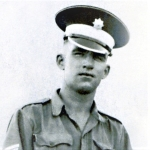
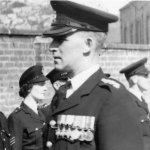
MCPHERSON, MacIntyre Wilson
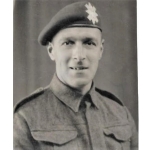
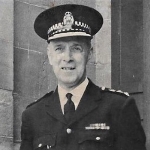
MEDDINGS, Sidney William
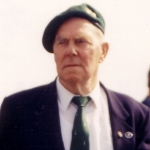
MEEK, Angus
MELLARS, Vivian Roy
MILBURN, John
MILBURN, Ridley
MITCHELL, William
MITCHELL, William Henry
MOFFAT, Robert Tweedie
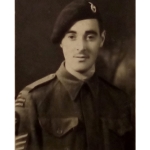
MOLD, Herbert John
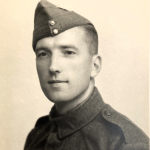
MONEY, Douglas Anthony William
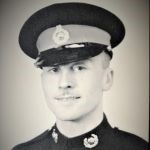
MORGAN, Albert Stuart
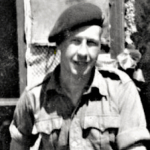
MORRIS, Charles, H.
MORRIS, Leonard Christopher Hugh
MULLARD, Sidney John
MUNNS, Leonard Cyril
MYNHEER, Frederick Robert Charles
NAYLOR, Howard
NEALE, Arthur
NEWBY, Kenneth
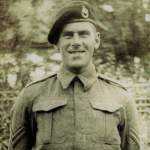
NICHOLAS, John David
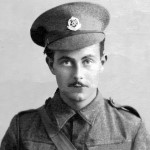
June 1940 attested into the Corps of Military Police.
April 1941 transferred to the Infantry Training Centre (Welch Regiment).
15 April 1941 posted to the Auxiliary Units.
NICHOLSON, James
NICOLSON, Angus
O'SHEA, James Andrew
OLIVER, Matthew Dudgeon
OLIVER, Matthew Dudgeon
OLIVER, Roland
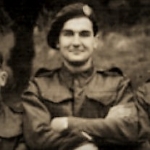
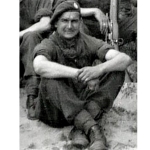
OSTICK, Ernest
OVENDEN, Roderick Joseph
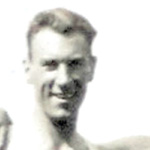
PAGE, Thomas Harold
PALFREY, Edward Francis
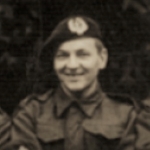
PALMER, Frederick
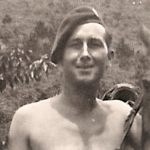
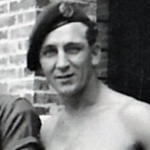
PANTALL, Richard William White
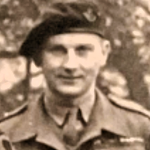
PARISH, Kenneth Peter
PARKER, Robert John
Guardsman Robert Parker was reported missing 26 February 1943 during operations in North Africa (Battle for Steamroller Farm) and later found to be a prisoner of war.
PASK, Douglas
PAUL, Haydn Bertram
PEARCE, Kenneth
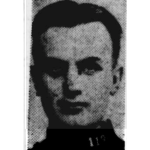
PEARSE, George
PETKEN, William Henry
PHILLIPS, Hedley Joyce
PHILLIPS, Norman Arthur Firth
- 1939 employed as a Clerk at the Education Offices, Bath.
POCOCK, Thomas Charles
PORTWAIN, Edward
POWER, John Francis Finbar
PRATT, Henry
PRICE, David Elvet
PULESTON, Geoffrey Frank
RAMAGE, James, B.
RAMSDEN, Harry
RATTLE, Jack Ernest
REEVE, Stanley Richardson
RENSHAW, Victor Ernest
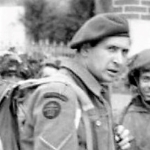
RIDGE, Thomas William
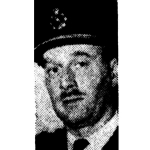
RILEY, Charles George Gibson
ROBERTS, Charles Edward James
ROBERTS, Donald Leslie
ROBERTS, Edwin Albert
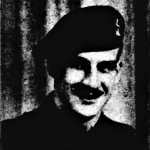
ROBERTSON, George
ROLFE, Charles Kenneth
ROSTANCE, James, H.F.W.
RUSHTON, Edward Gordon
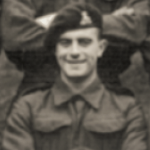
Edward was a Police Officer in Lancashire who had volunteered for the Commandos as part of the Police Intakes. In 1939 he was a Police Constable residing at 12 Crabtree Street, Colne.
SALISBURY, Frank
SAVORY, Dennis
SEARLE, Clifford Frederick
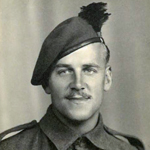
SIGSWORTH, Stanley
SMART, Albert Kenneth
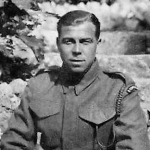
SMITH, George Alfred
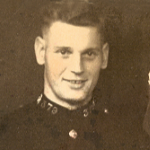
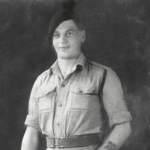
SMITH, Miller
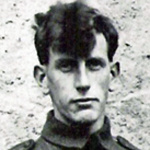
Sergeant Miller Smith, a former Police Officer, was one of seven men from No.2 Commando captured after Operation Musketoon and later executed at Sachsenhausen Concentration Camp under Hitler's Commando Execution Order.
SNADDON, John
John Snaddon was a Fife Constabulary police officer who volunteered for the Commandos in 1942 joining a Police Intake to the Commando Depot (Commando Badic Training Centre) at Achnarry. Lance Corporal Snaddon, No.5 Commando 4 troop, was wounded in 1944 during operations in Burma.
SPINKS, Edward George
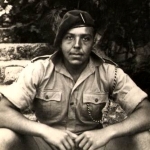
STACK, William John
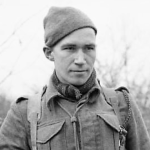
In 1939 William Stack was a Police Constable based at Central Police Station, Cheltenham. He volunteered for the Commandos in 1942 as part of the Police Intakes to the Commando Depot (Commando Basic Training Centre), Achnacarry. He was posted to 5 Troop after joining his commando unit.
STARLING, Alfred Michael Prestwood
- 1939 Police Constable residing at 29 Carlyle Road, Birmingham.
STORER, Sidney
STROWGER, John Dunkirk
John Strowger was a Metropolitan Police Officer who volunteered for the Commandos. In 1939 he was a Police Constable serving at Croydon Police Station, London. Post war member of the Commando Association.
TANNER, John Andrew
Corporal John Tanner was killed in action on 15 April 1945 during operations at Lake Comacchio, Italy. The previous year on 20 March 1944 he was wounded (recovered) during operations in Italy.
TAYLOR, Thomas Alfred
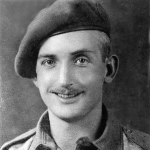
TAYLOR, William Ronald
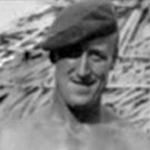
TENNICK, Maurice William
TEVENDALE, Lewis Legertwood Legg
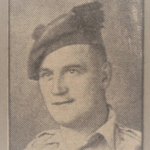
TEWKESBURY, Edward Frank
THOMSON, John, D.
John Thomson was a serving Police Officer who had volunteered for the Commandos as part of the Police Intakes. In 1939 he was Police Constable No.84 residing at the Police Billets, Albion Assembly Rooms, Norfolk Street, Tynemouth.
THORNTHWAITE, Norman
TOOGOOD, David Cyril
TORDOFF, Kenneth
TOUGH, Alexander
TOVEY, Norman Charles
TOWSE, Alfred Burley
TUDOR, William John
TUFFIN, Leslie Ernest Longhurst
TUNGATT, Leonard Frederick
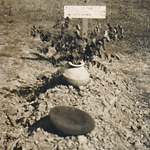
TURNER, Richard Kirkley
- Evacuated back to the UK and to a hospital in Durham [2a][3].
TURNER, William George Jack
TYREMAN, George Vincent
WAKEFIELD, Raymond
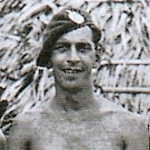
WAKELY, Terence Raymond John
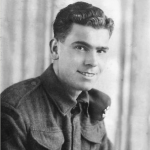
WALL, Reginald George
- 1939 Metropolitan Police Constable at Croydon Police Station.
WARD, Arthur William
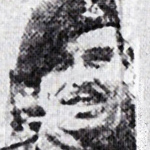
WATSON, J.R.
WATTS, Robert Edward
WEBB, George Henry
WEBB, Henry, T.
- 1939 Metropoltan Police Constable at the Police Station, 370 Romford Rd., East Ham.
WEBSTER, Roland Hutchinson
WEEKES, Sydney George Douglas
WELCH, Frederick Edward
WHITE, Horace George Lewis
WILLIAMS, Albert
WILLIAMS, Francis Arthur
WILSON, Graham Charles
WOOD, Hector
WOOLLARD, George
WORMLEY, Wilfrid John
WRIGHT, Harold
A newspaper article about Police Intakes
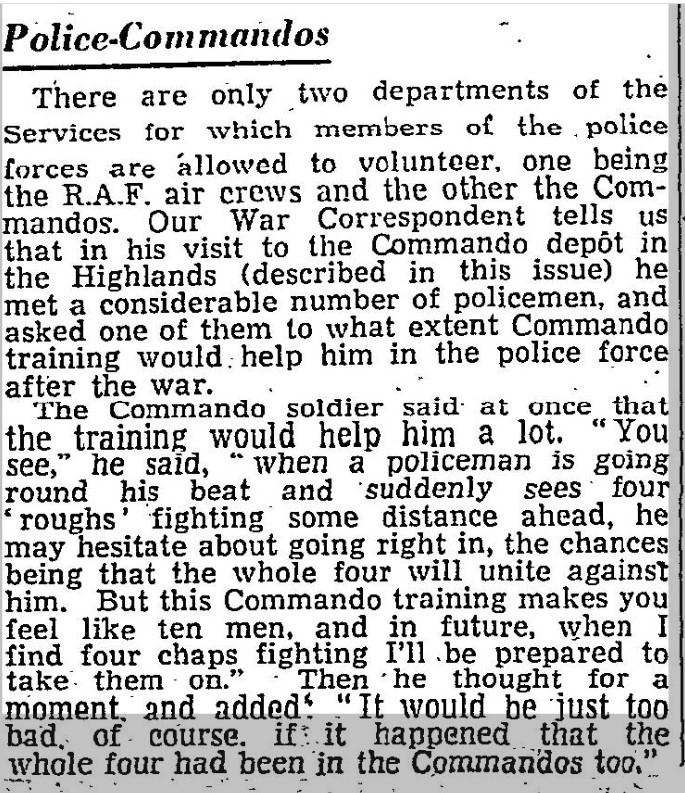
Published in The Scotsman 15 January 1943.
A newspaper article about Scottish Police War Service
A newspaper article on Lancashire Police Officers in the Armed Forces
Police Intakes (Royal Marines)
-
John FISHWICK (Northampton Borough Police Force).
-
Alf BENNETT (Northampton Borough Police Force).
-
Reg ROSWELL (Northampton County Police Force).
-
Alf BROWN (Northampton County Police Force).
-
Stan BEAVER (Northampton County Police Force). Possibly ident with [more....].
Commando Memorial at Spean Bridge
 The Memorial at Spean Bridge was unveiled by Queen Elizabeth the Queen Mother on Saturday 27th September 1952. There was no parade or ceremonial drill. The Queen Mother expressing a wish to walk through a line of Commandos on the way back to her car.
The Memorial at Spean Bridge was unveiled by Queen Elizabeth the Queen Mother on Saturday 27th September 1952. There was no parade or ceremonial drill. The Queen Mother expressing a wish to walk through a line of Commandos on the way back to her car.
A full history of this Memorial, and others, can be found via the main navigation menu on the Home page here: Commando Memorials
Read on from below right.....
Origins of the Green Beret
The origins of the Green Beret issued in 1942 are explained within the Commando Insignia and Memorablia album of the Gallery [ Read in Gallery.... ].
[Image] The Green Beret of Bob Mewett No.12 Cdo. and No.1 Cdo.]
